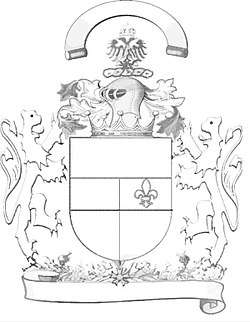List of oldest heraldry
| Part of a series on |
| Heraldic achievement |
|---|
| Conventional elements of coats of arms |
|
|
This list of oldest heraldry aims to include the oldest documented, non-attributed heraldic achievements for individuals, families, locations or institutions.
A problem with determining early occurrence of heraldry stems from the fact that many early heraldic charges and compositions emerged in emulation of prior visual identifications, as seen in ante-heraldic seals and standards of individuals, authorities and towns, well before traditional heraldic custom was established. Visual culture and identity naturally predated heraldry. Notably, lions that would subsequently appear in coat of arms of royal dynasties, such the Kingdom of León, predated heraldry well enough in the early Middle Ages.
In an extreme comparison, some elements today commonly associated with heraldry have even been traced in Western civilisation to antiquity, such as to the Lions gate of Mycenae from the 13th century B.C. A reoccuring, less distant perception of proto-heraldic appearances is that of the Bayeux tapestry (11th century) in Normandy, following the Battle of Hastings (1066).
It has been suggested that the use of heraldic devices in western Europe was strongly influenced by the return of noblemen from the First Crusade (1095–1099). King Alfonso VII of León started using a lion device in 1126 and the lion was already used as heraldic emblem in 1148. Henry I of England may have been using a lion as a heraldic device during his reign in the early 12th century. A later chroncler would claim he awarded his son-in-law, Geoffrey V, Count of Anjou, a lion device in 1127, and several lineages descended from Henry would use lions on their coats of arms once full-fledged heraldry developed. The earliest known heraldic representation appears on the funerary enamel of Geoffrey of Anjou (d. 1151), showing a coat of arms that appears to be the same as one later used by some of his descendants, though it has been pointed out that they may be merely post-mortal, attributed coat of arms. Even so, it would still demonstrate the development of heraldry within a short time after his death. Likewise the early seals of King Richard Lionheart of the House of Plantagenet are usually taken as a manifestations of heraldry, due to the apparent similarity between the shield represented on the second Great Seal and the documented coat of arms used by the British royal family shortly afterwards.
List of oldest heraldry
| Year | Contemporary | Modern | Type | Armiger/attribution | Occasion | Grant | Location | Notes |
|---|---|---|---|---|---|---|---|---|
| 1155-1160 | 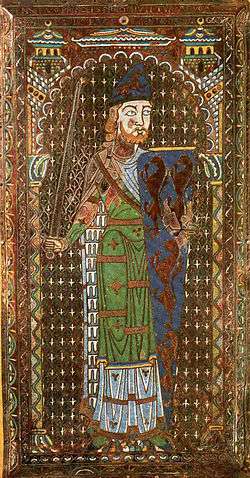 |
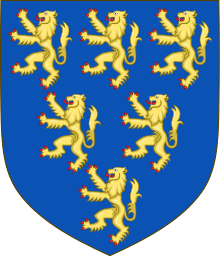 |
Personal, then family coat of arms |
Geoffrey Plantagenet, Count of Anjou | Self-assumed or post mortem attributed arms |
Le Mans Cathedral, Le Mans, |
Appearing on funerary enamel commissioned by Geoffrey's widow Mathilda of England between 1155 and 1160 for his tomb. Often described as the first documented personal coat of arms. A chronicler wrote that in 1127, King Henry I presented to Geoffrey a badge of a gold lion.[1] Some scholars represent this as an earlier description of the same heraldic device, and perhaps the same coat of arms. | |
| 1189 | 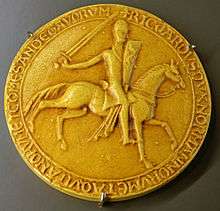 |
.svg.png) |
Personal, then family coat of arms |
King Richard the Lionheart; House of Plantagenet |
Great Seal of the Realm |
Likely self-assumed | History Museum of Vendée, |
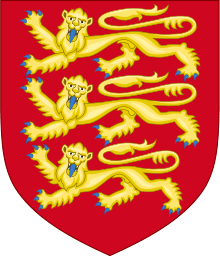 Possibly the first documented royal coats of arms of the United Kingdom as well as royal coats of arms at all. Colours are unknown from seals, but that of the Second Seal likely matched the coat used by his successors, with three gold lions on red. |
| ca. 1194 | .jpg) |
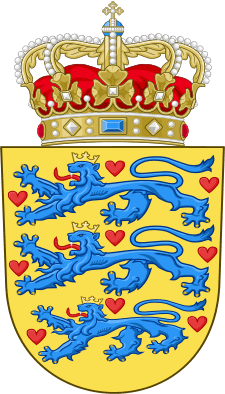 |
Personal, then family coat of arms |
Canute VI of Denmark; House of Estridsen |
Likely self-assumed | St. Bendt's Church, Ringsted, |
Seal of Canute VI likely used around 1194, and is in principal the same coat of arms that Denmark uses today.[2] | |
| before about 1255 | .jpg) |
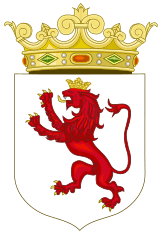 |
Personal, then family coat of arms |
Alfonso VII of León, Castile and Galicia, called the Emperor; House of Ivrea |
Self-assumed | Santiago Cathedral, Santiago de Compostela, |
King Alfonso VII (1126-1157) is first reported using a lion as a personal emblem in Chronica Adefonsi imperatoris when it describes the armies participating in the taking of Almería. Martín de Riquer insisted that the lion was already used as heraldic emblem in 1148.[3] The earliest conserved heraldic representation appears on illustrations of Ferdinand II (1157-1188) and Alfonso IX (1188-1230) in the Tumbo A Manuscript of Santiago de Compostela Cathedral. The charters in this manuscript span from the early-12th to mid-13th centuries, and it is unclear when the illuminations were created nor whether the arms depicted for Ferdinand II and Alfonso IX represent contemporary usage or are attributed arms based on the use by their descendants. It is essentially the same coat of arms that the city of León uses today.[4] | |
| 1281–1294? | 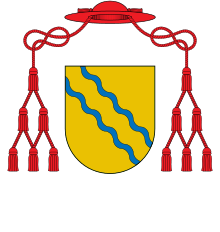 |
Papal coat of arms |
Pope Boniface VIII | Likely self-assumed | Supposedly the first documented Papal coat of arms (although older undocumented are indicated), likely assumed sometimes as Cardinal (1281–1294). | |||
| 1290's |  |
Ecclesiastical heraldry |
Diocese of Ely | Possibly the earliest documented coat of arms for a diocese.[5] | ||||
| 1369 | 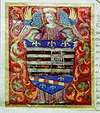 |
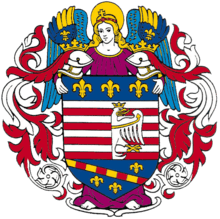 |
Civic heraldry | Košice, Slovakia | King Louis I of Hungary | Diósgyőr Castle near present-day Miskolc, |
Claimant to be the oldest coat of arms of a town. | |
| 1441 |  |
Academic heraldry | King's College (Cambridge) | King Henry VI | Cambridge, |
Possibly earliest documented coat of arms for an academic institution, at least in England. |
See also

- Bayeux Tapestry (11th century)
External links
References
- ↑ Wagner, A. (1946). Heraldry in England
- ↑ Bartholdy, Nils G. (1995). Denmark's Arms and Crown (in Danish). Copenhagen: Ministry of Culture. p. 16. ISBN 87-87361-20-5. Retrieved 26 May 2017.
- ↑ Riquer, Martín de (1942) Manual de heráldica española. Barcelona: Apolo.
- ↑ Chao Prieto, Ricardo: La Bandera Medieval del Reino de León [The medieval banner of the Kingdom of León]. Banderas, No. 98, Spanish Society of Vexillology. Retrieved 14 August 2018.
- ↑ Briggs, C. (1970). Civic and Corporate Heraldry
